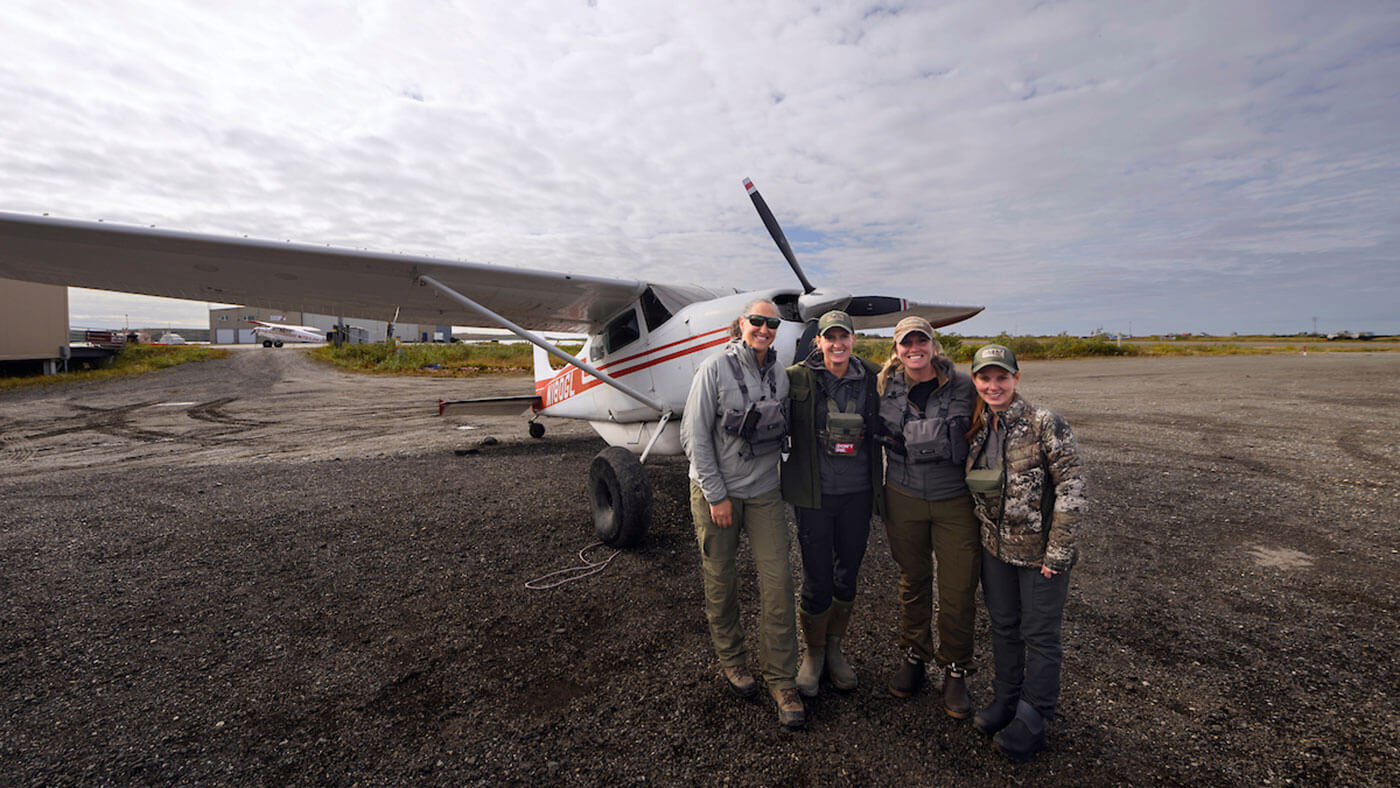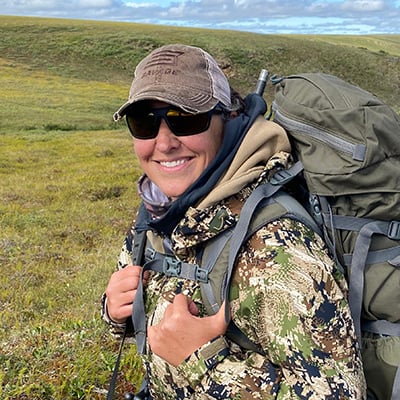- Savage Blog
- Alaska DIY Caribou Hunt: Women Conquer the Tundra
Alaska DIY Caribou Hunt: Women Conquer the Tundra
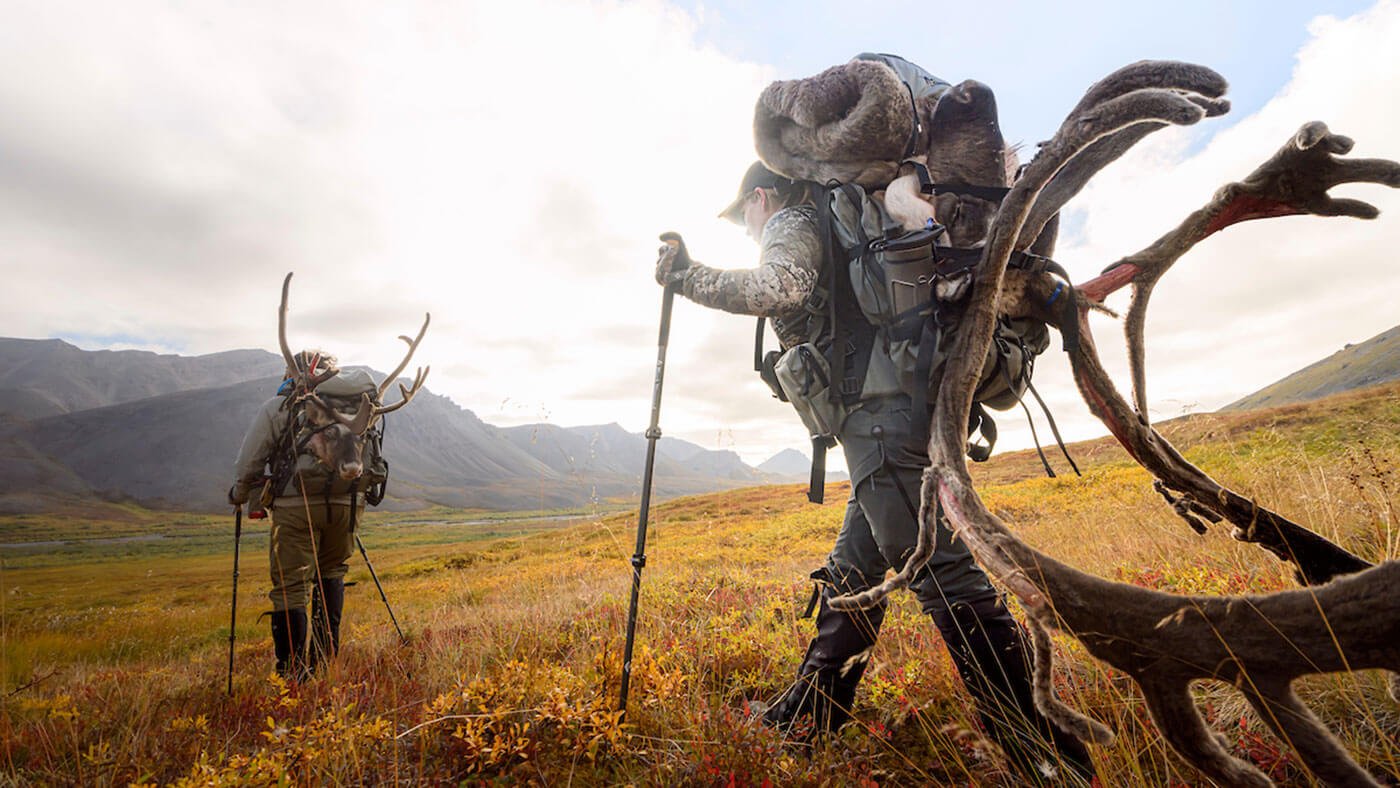
It’s January 2023, I am at SHOT Show getting introduced to someone I am told I MUST meet. Tess has been a well-known face in this industry for years, showcasing her talent as a photographer for many organizations and events. I had hunted with her partner, David, many times, and he told me that I really needed to get to know Tess and spend some time with her in the field. After a brief conversation in our booth at the show, we found that we shared a common energy for adventure and challenging ourselves in our hunting endeavors. We walked away from SHOT Show with a plan to explore an Alaska DIY caribou hunt for the fall of 2024. Tess has done this hunt in the past and spoke highly of the group we would use to help get us into the field. Our goal was to round out our group of hunters and put together a group of four women who would sign up for the challenging hunt. Tess reached out to her good friend and industry veteran, Kali Parmley, who quickly said yes. Tess and Kali did this hunt in 2022 and were both excited about the chance to get back into the wilderness of Alaska. Our fourth member became Kelsey, another industry veteran with ample hunts under her belt, but nothing like this on her resume.
Over the next year, we locked in the dates, and started focusing on the gear we would use in the field, but nothing had really kicked into motion when we all sat down at SHOT Show 2024. Kelsey and I had a lot of questions, more about logistics and gear than anything. As a group, we narrowed down our choices for firearms, ammunition, optics, packs, apparel, and all other key categories. We knew what was crucial to the success of the hunt and made sure we partnered with the brands that would help us succeed. We all walked away from that meeting excited for what was to come in the next eight months.
As spring turned to summer, we were all in prep mode for the trip. Rifles arrived with ammo and optics in early June. With this being a backcountry hunt, on a big game animal, we knew there were a few factors that we needed to prepare for. First, weight mattered. We chose the 110 Ultralite Elite rifles, coming at just under six pounds. We paired that with Hornady Outfitter 160gr. 7mm PRC rounds. Finally, we knew that shots could range from 30-300 yards plus, so we needed a trusted optic that we felt comfortable with, especially if we had to make range calls and adjustments quickly in the field. We went with the Burris Veracity PH 3-15x44. Once we were sighted in, the simple heads-up display (HUD) was synced up with the Burris app to allow us to make range adjustments in the field easily. I chose to zero my set-up at 200 yards, giving me great flexibility from 100-300 yards once on the tundra. By August, my rifle setup was dialed in and ready for the trek north.
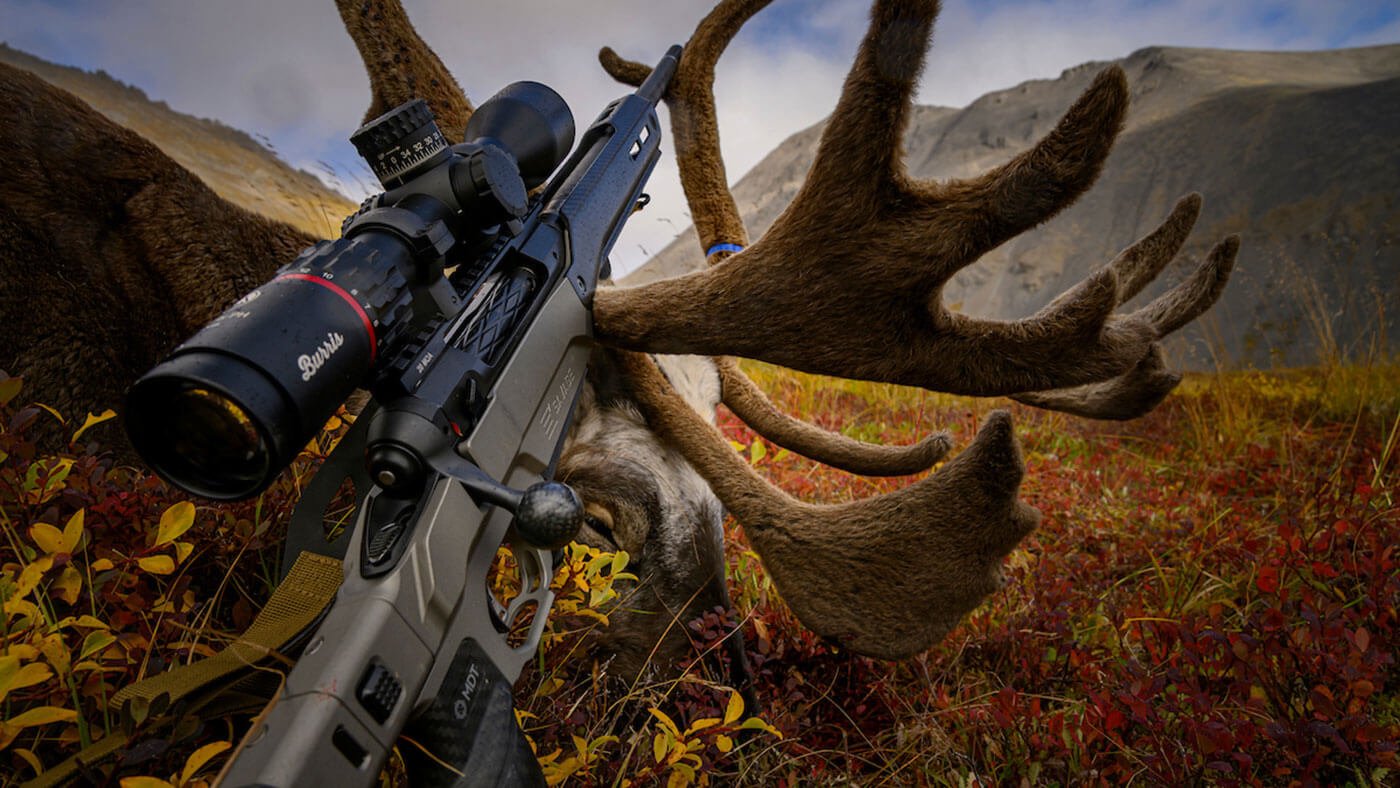
While the outfitter took care of some of our needs in the field, it was up to us to make sure we had our own gear prepared. We needed to be ready for anything, rain, snow, bugs, wind, and more. I spent the better part of four months making sure the gear I had was enough, buying new gear, and making sure that I was ready, physically and mentally for this hunt. With our new Stone Glacier packs in hand, I started trekking in the Black Hills of South Dakota on a daily basis. I hiked with my pack over one hundred miles the final two months before our trip. I knew the physical demands of the hunt would test me more than anything else I had done, so I wanted to make sure I was as prepared as I could be.
The other area I focus on as I prepare for an event like this is to educate myself as best as I can for whatever may come our way. I read stories, watched videos, and immersed myself in any content I could find from people who have done a similar type of hunt. Having been to Alaska on a guided hunt in 2020, I knew the terrain and the weather that we would be dealing with. I also knew how illusive the game could be. Luckily, this time we are going a month later than I did in 2020. Back then, we saw 4 satellite bulls in seven days as we were too early for the migration. Being late August this trip, we were hoping to see more movement from the caribou.
With two weeks to go, my office floor looked like a person trying to stop hoarding and prepping for a rummage sale. I had everything and more that I would need laid out. Each pile of gear was labeled for its function. Weather gear, first-aid/safety gear, survival gear, layers, field dressing kits, and more. To calm my mind, I went through our packing list three times and made sure I had accounted for everything. Being a DIY hunt, I was responsible for anything I could need in the field. Yes, the four of us talked about who would bring what, but when it came down to it, we each needed to be as prepared as we could be with our own gear. That added pressure to my preparation which I had not experienced before.
Fast forward to August 26th, and the car was loaded to head to the airport. There are always some nerves when it comes to checking all your gear, firearm, and all your essentials for a trip like this with the airlines. Luckily, all four of us, and our luggage made it to Anchorage without delay or issue. Piled into the minivan, we hit Cabela’s to get our licenses and tags, and then the grocery store for the last-minute must-have snacks: Uncrustables, Bagels and Cream Cheese, and some steaks for our first night in camp. With that final stop, we were now ready for our final couple of flights to get us to the backcountry.
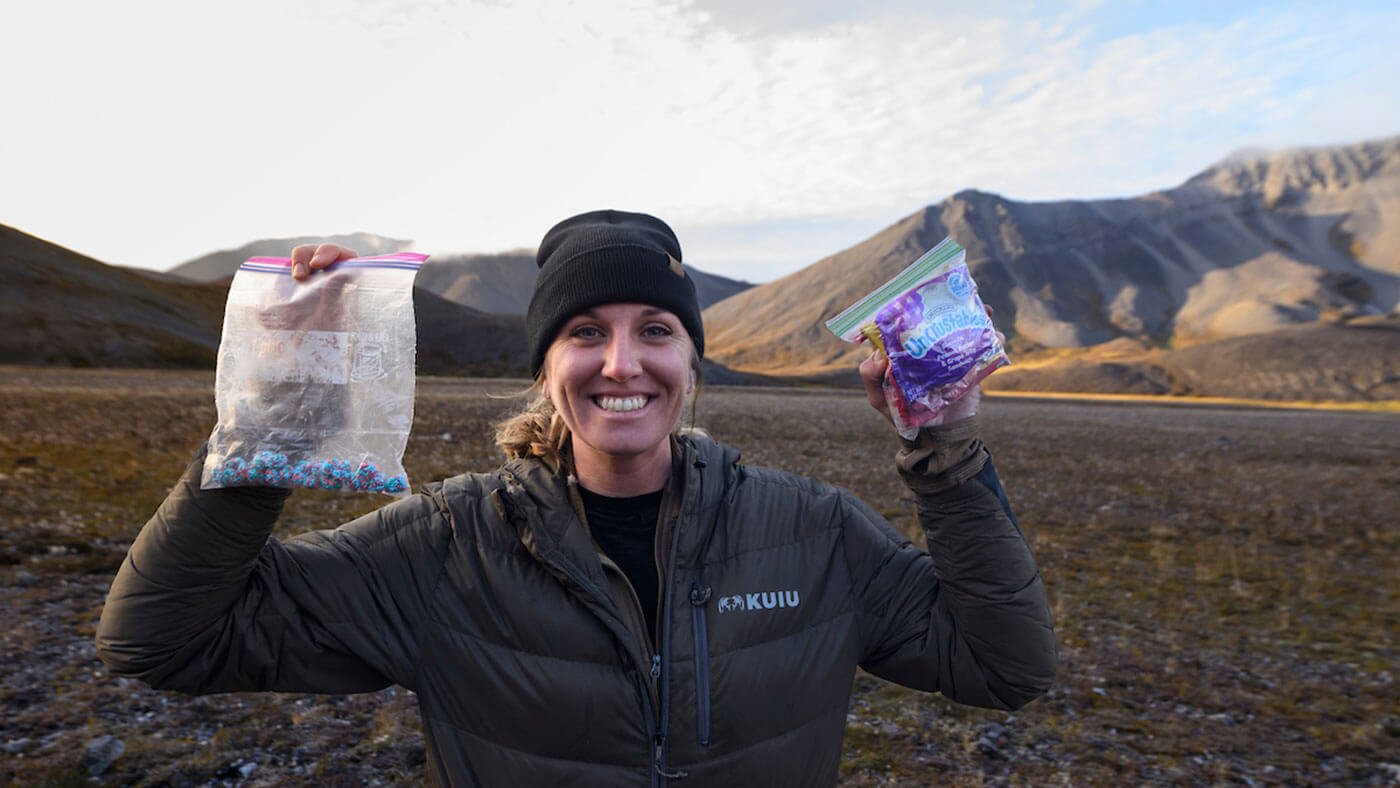
August 28th, we flew to Kotzebue, and then met at Ram Aviation to pair down our gear, repack anything we needed, and load up the two Cessna’s for the trip into the tundra. As we flew close to camp, our pilot took us around some high plateaus where we spotted multiple herds of caribou. This was all I had wanted to see. I was smiling ear to ear as we landed in our camp, only a few miles from where we had seen the caribou on the flight in.
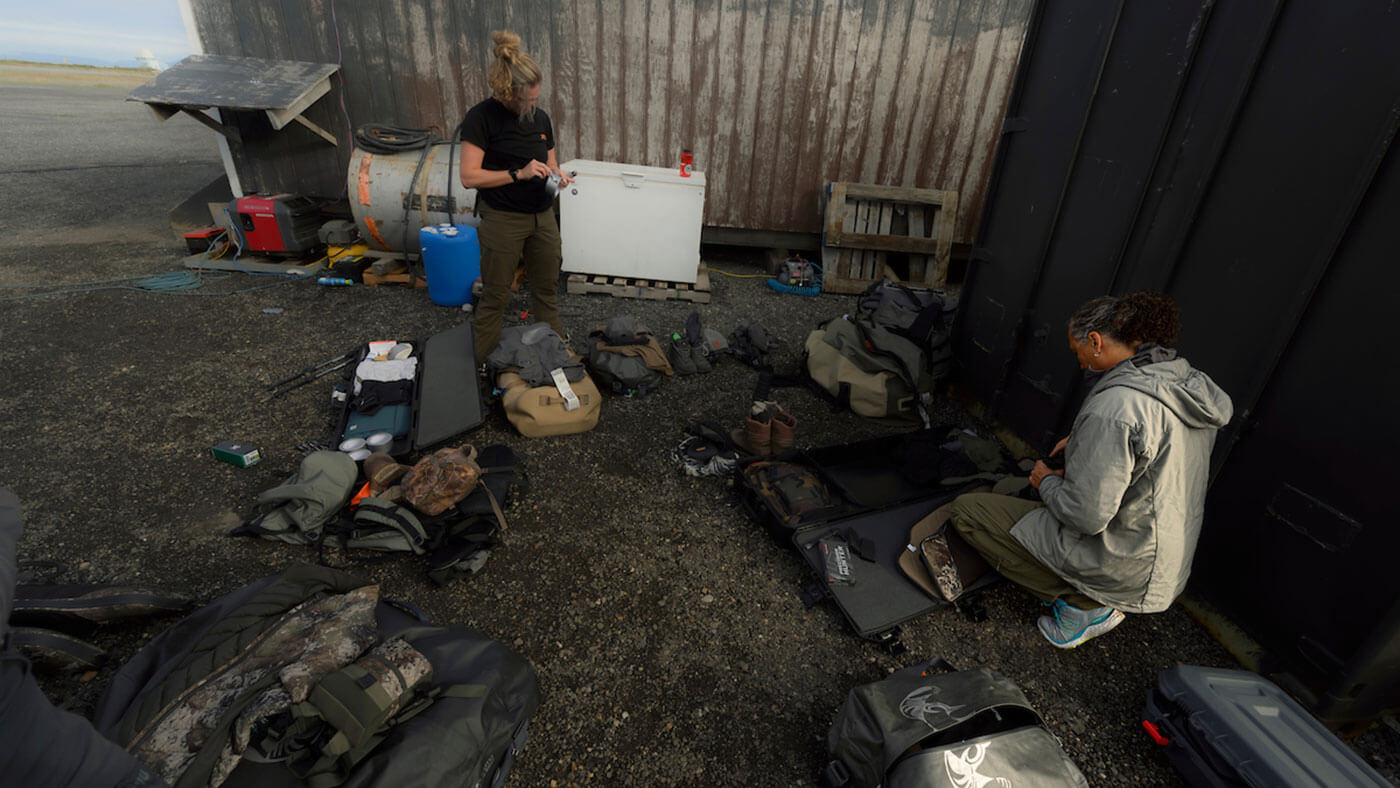
By 3:30pm, we were dropped, along with a pile of gear, and the two planes flew off, leaving the four of us on our own for what should be a five-day hunt. More to come on the SHOULD comment later. As the planes took off, all four of us jumped into action getting our camp set up, getting water filtered and back to camp, and finally, setting up our cots and prepping our gear for the first day of the hunt that will start on August 29th.
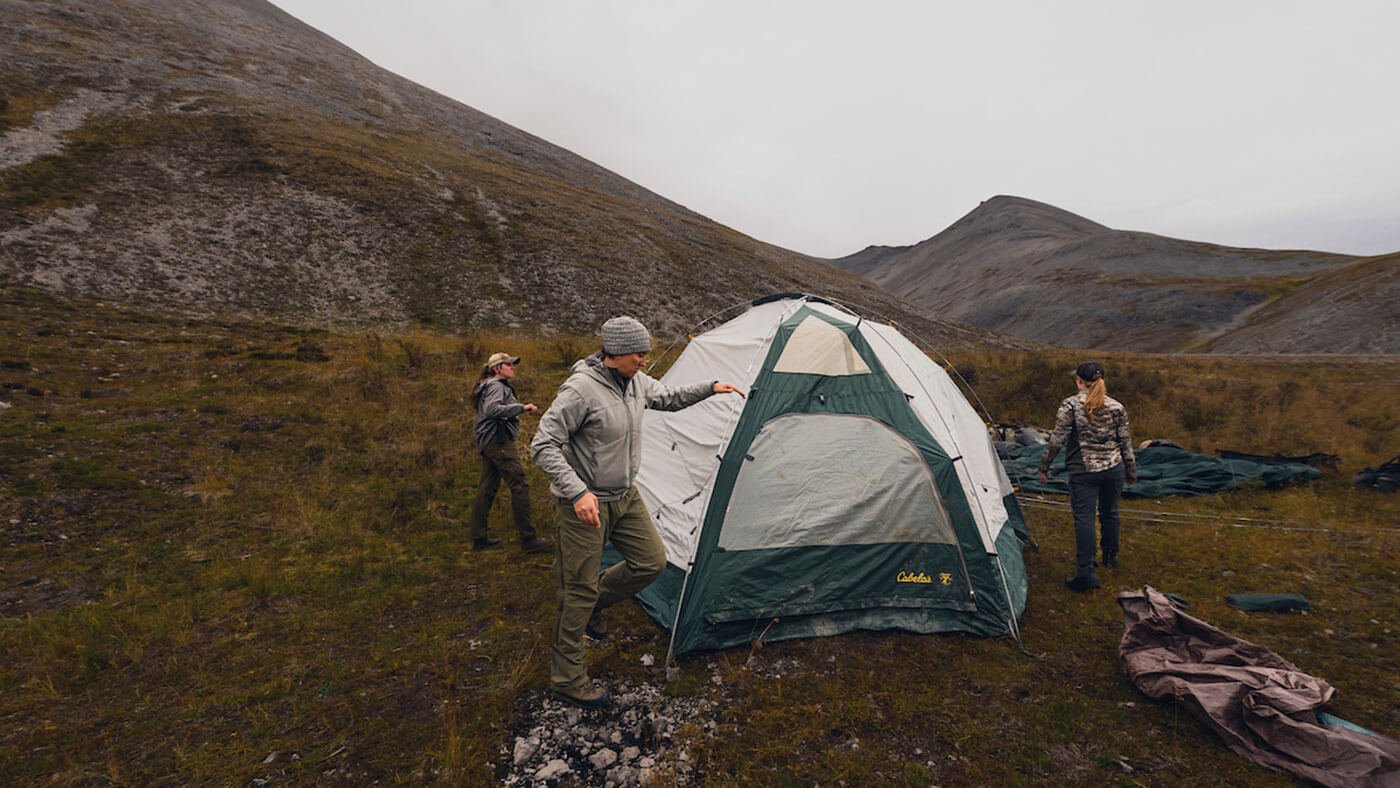
As the other three were finishing set-up in the sleeping tent, I made my way to the food tent to start setting up. As I stood unpacking the tent, I heard the four-letter word that we were all concerned about……. Bear. I stood up and saw the three of them looking towards the river. From my vantage point, I could not see the bear, so I slowly worked my way the 75 yards to where they stood. We watched the bear move towards us, across the river, and come within 260 yards. We started making noise, waving our arms, and to our delight, he decided to keep moving downriver. As I sometimes do on my hunts, I thought we should name the bears we encountered throughout the week. We landed on naming them with the great names of The Beatles. This first bear was now Ringo. By choosing a band with only four members, we were hoping that we would not need to use all band members as bear names this week.
With the bear excitement now behind us, and two of us armed with bear spray and two with sidearms, we enjoyed an amazing first dinner in camp, thanks to Kali and Kelsey. Steaks, potatoes, and onions were the perfect meal to share in the field as we all finally took a breath and shared thoughts and questions about what was to come. The area where we were dropped was quite different than where Tess and Kali hunted in 2022. We were surrounded by mountains of shale and had a valley laid out before us with a winding riverbed down the middle. Whichever way we went, we knew we were going to be putting in some miles, and we could not wait.
As I climbed into my sleeping bag for the first time, in the backcountry, on our own, I had my first and only moment where I asked myself, “What the hell have I gotten myself into?” After a few deep breaths and remembering all the prep work I did to be physically and mentally ready, those thoughts quickly faded as I fell asleep to the utter silence of the tundra.
Morning one, we all wake up early without an alarm. Slight frost on the ground was our first sight, only to be outdone by the pure blue sky we saw in front of us. We had heard that August had been nasty for weather until we arrived. We were blessed with sunshine, and we were not going to take that for granted. After our bagels, cream cheese, and coffee, we were loaded up and off for day one, chasing barren ground caribou in Alaska.
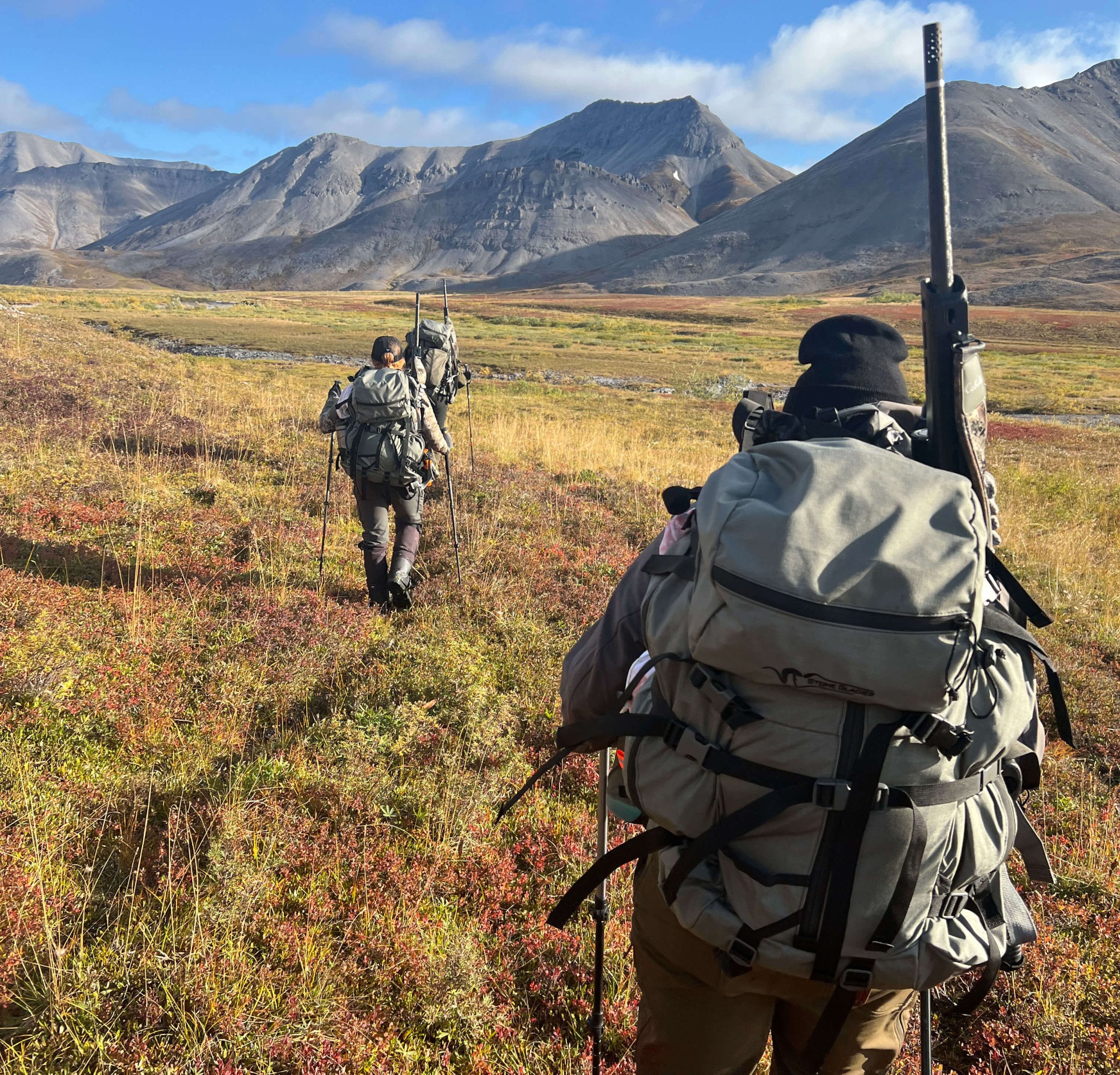
We trekked away from camp, working our way across the muskeg as we approached our first hillside to glass. Only a little more than a mile from camp, we found our first small herd of caribou. Roughly 8-10 young bulls, working their way down a draw and towards the river. I pride myself on being a decent spotter, so as I took one last glance up the draw before we jumped to the riverbed to head off the group of bulls, I noticed a white dot that I needed to look at. I threw up the binos up and saw enough that it warranted getting the spotting scope out. With one look, we heard “That’s a good bull.” Kelsey was up first, and we now had her first target on the radar.
We worked our way along a hillside, to be able to look back up the draw at the bedded bull. As we analyzed our route to get in range, we had options. Some options we liked; others were not preferable. Being that it was one hour into the hunt, and these caribou are not as skittish as whitetail or other big game species, we chose to walk in an area where we could be seen, but hopefully not spook the bull. We managed to get behind a few undulations on the hillside and work within 250 yards of the bull. Kelsey got a look at him and decided that if the bull presented a good shot, she would take it.
As we worked up a small hillside, the bull stood up. Kelsey quickly got her pack down on the ground while Kali got her a range on the bull. Just over 230 yards, perfect for what Kelsey had practiced for. We all sat down in silence as we waited for the bull to turn broadside and give Kesley the shot she was ready for. One more step, and it was time. Kelsey steadied herself on the pack, Kali calmly talked her through the shot, and with one final step from the bull, she squeezed the AccuTrigger and the shot found its mark, perfect lung shot. I watched through the spotting scope as the bull took a few steps down a hill and then collapsed. It’s what every hunter wants, a perfect broadside shot, great placement, a bullet that does its job, and a quick, ethical kill. One hour into the hunt we were already on cloud nine.
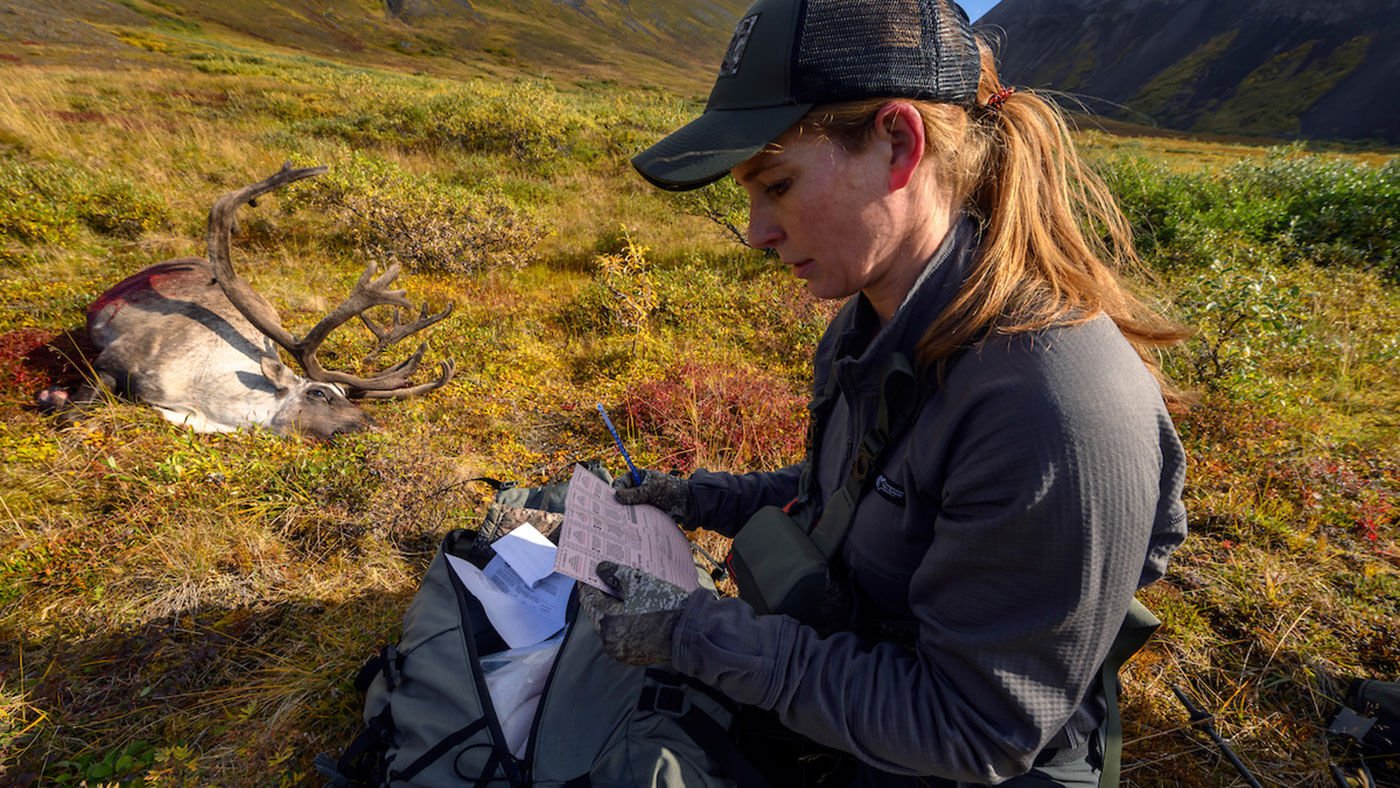
As often happens in hunting, you can prepare for many scenarios, but nothing happens like you think it will. As Kelsey’s bull had stood up, we were amazed to see that he was not alone. Another bull stood with him and stayed back to his right. As Kelsey shot, the other bull worked down to the right around a small hill that lay directly in front of us. We waited to make sure that we saw no movement from Kelsey’s bull. As the second bull moved slowly down the draw, he was working directly alongside us. I don’t remember who said it, but someone said, “Anyone want that one?” Those of you that know me, know that I am not a patient or picky hunter. I have tasted caribou meat and wanted more of it in my freezer. I had done a hunt where I saw four bulls in seven days. So, when a decent bull was standing 195 yards away from me and only a couple miles from camp, I took my chances. I quickly got my rifle off my pack, laid my pack on the ground in front of me, and got comfortable in a prone position. Deep breathe, squeeze, and reload. And just like that, two of us were tagged out, after just 75 minutes of hunting.
This is the part that I have been playing back in my head ever since the second I took the shot. Every hunter will tell you stories of shots they took or didn’t take and what they wish they would or would not have done. This hunt turned into the latter for me. Hindsight is 20/20, we all know that, but as we were working on field dressing and quartering mine and Kelsey’s caribou, Kali was on bear lookout and found a great group of mature bulls working their way down the riverbed not more than a mile from us. Should I have waited? Should I have passed on my bull and taken the chance that we would see others? I will be asking myself those questions for a very long time. I didn’t shoot the biggest bull, many would probably have passed, but in the moment, knowing what I knew and had heard, I didn’t take the risk of coming home without a cooler full of meat.
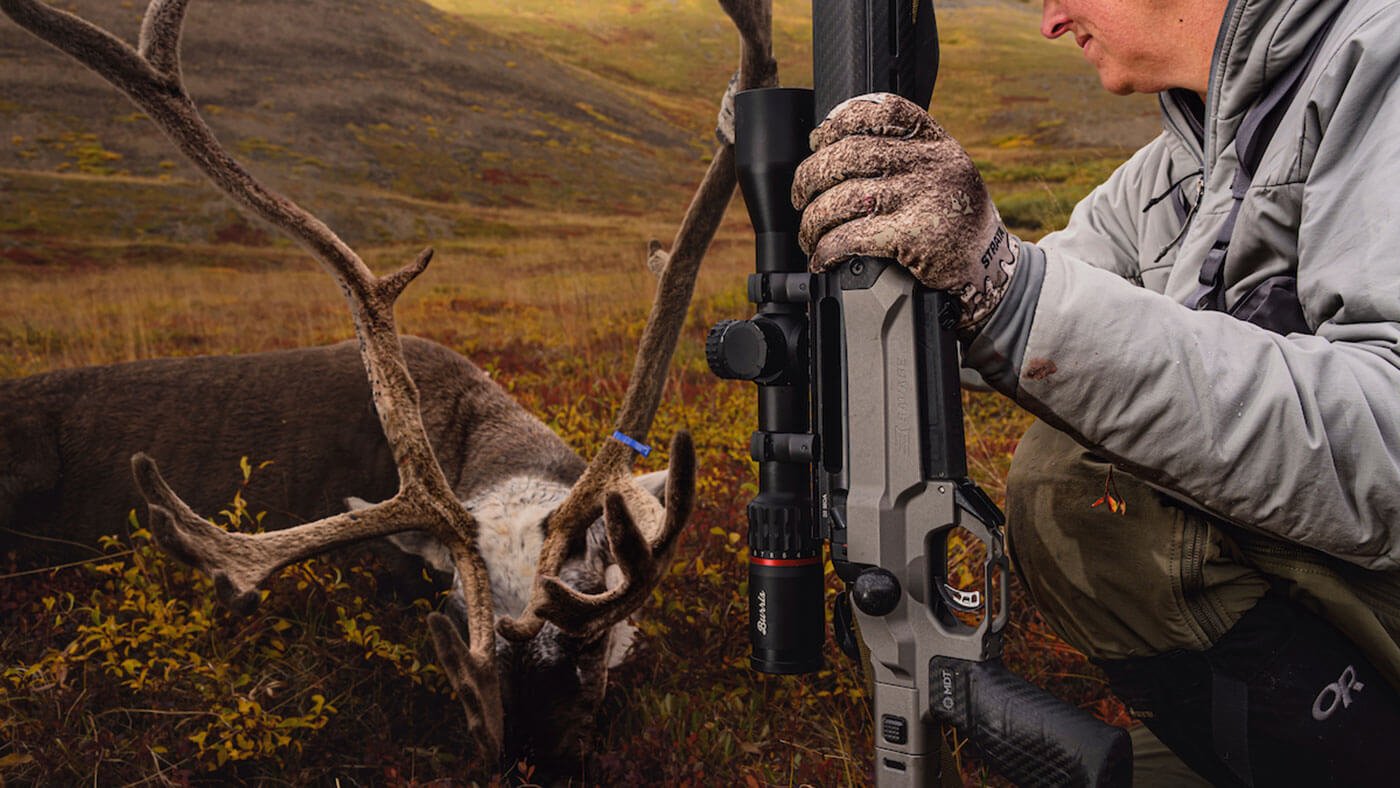
We spent the rest of the day hauling out the meat from the two bulls. Having four hunters in camp helped make quick work of getting the meat back to our cache area. With my meat safely tucked 500 yards away from our camp, we circled back to get Kelsey’s. We had moved her meat down the hillside to make the pack out easier for haul number two. Heavy packs, rough terrain, and the excitement of the day wearing off, we were all glad to get back to camp in time for an early dinner and give our bodies time to recover before day two of the hunt.
As we awoke on morning two, we found the same weather had blessed us in camp. We slept in a little, and after breakfast, we were off back down the riverbed into the valley where Kali had seen the bulls the previous day. As luck would have it, we found them in a similar area, and in a spot that we could get close to. We worked further away from camp than we were planning to, but when you are here to hunt caribou, you need to go where they are. We worked our way up a small ridge along the riverbed, hoping to get eyes on the large group of bulls that were feeding roughly 350 yards from us. As we crested the ridge, I was in the rear of the group and witnessed the well-known “freeze” posture from Kali. She dropped down, as did Tess. Kelsey and I worked our way slowly to them to witness two bulls staring at us 75 yards away. Luckily as they ran off towards the herd, they did not spook the group.
We took this chance to drop back down and work around to get Tess closer to hopefully get a shot at her target bull. The good thing about our move is that we had a nice ridge as cover, but the bad thing is the number of eyeballs we had on us when we finally moved onto the same plane as the caribou and ran out of protection to try and get closer. We were just under 350 yards away. The bulls were tucked at the base of a steep hill, protected from the nasty wind that was whipping through the valley.
Tess had her eye on a beautiful bull that had huge tops and had recently shed its velvet. His rack was glowing red in the sunlight. Being able to sit and watch this group of mature caribou was everything I had wanted to see on this hunt. How often does a hunter get to look at the animals they are hunting, and take the time to analyze which one they may want to target? Well, we got that chance. For a half hour, we watched as the bulls fed along the hillside. Tess had her target bull, and we waited what felt like an hour for it to finally clear from the other bulls so she could get a shot. When he finally stepped clear, she took her shot. I was on the spotting scope and watched for an impact. The bull jerked like he had been hit and took a few steps forward, facing us straight on. The wind was swirling in the area where we were sitting and watching. None of us saw the impact either on the bull or on the ground. The tundra sucked up any visible evidence of where the round hit. With no clear injury from the shot, we wait for another shot at the bull. It took five more minutes, the bull standing motionless as others passed by him. Tess took one more shot and again, we could not see an impact on the bull or the ground around him. I went back and watched the first shot that I had recorded through the spotting scope, and it was clearly a miss, no shot hit the bull. Same with the second round. We waited and watched the bull, as the herd moved well beyond our range. We all kept eyes on the target bull as he worked his way across the hillside and over a ridge, confident that he was uninjured. We hoped to encounter him again tomorrow and get another shot at him, in better conditions.
With no bull to process in the field or meat to pack out, we headed back up the hill to retrieve the antlers and hide from mine and Kelsey’s bulls. If you have never trekked in the tundra, there are few words to describe the uncertain, ever-changing terrain you encounter. Just Google muskeg and tussex and you will understand. Hiking poles, solid boots, and a slow but steady pace will keep you safe. And a good pair of gaiters will keep you dry when you walk through puddles in the grass that you have no idea how deep they are. Once on the ridge, we got back to work. Luckily, the four-letter word did not find our kill spots the night before, so everything was intact. After securely loading up the antlers and hide, we started the nearly two-mile journey back to camp. Only having one load to pack out this day was not a bad thing. With our complete bulls now stashed away safely from camp, we returned to our food tent for another night of warm food, good conversation, and reminiscing about the past days’ encounters.
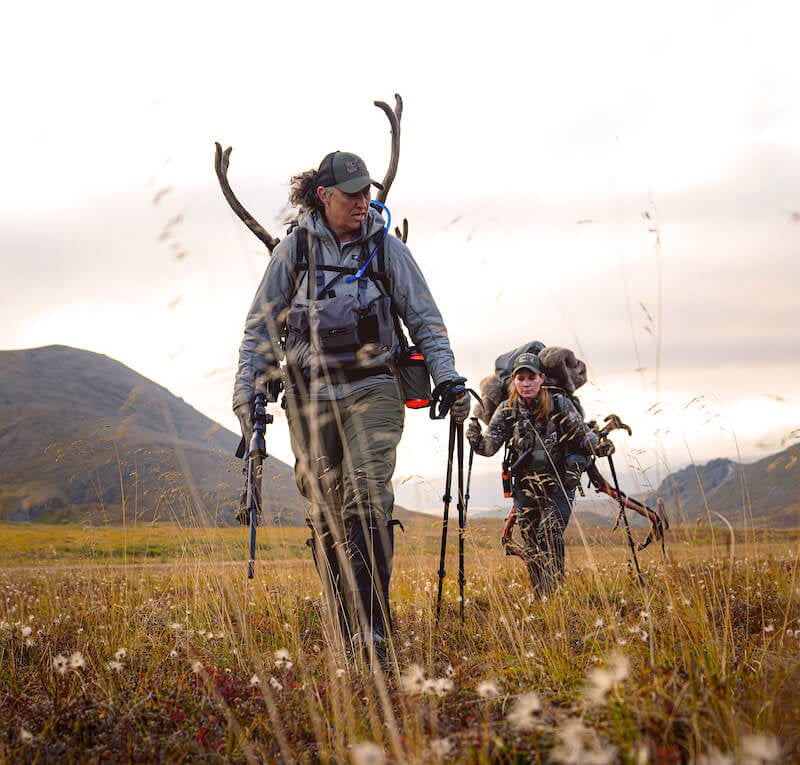
Day three we decided to get on the road a little earlier than we did on day two. We had seen those same bulls in a similar area now, two days in a row. After more bagels, cream cheese and coffee, we were back on our riverbed on the chase for bulls for Tess and Kali. We had a landmark that the pilots had labeled four-mile rock. We swore we would never trek to it, as four miles from camp is a long pack out. Luckily, they must use aviator mileage, because the rock was only two miles from our camp. Day three, that rock was our target. We would be able to climb a little higher and get a good vantage point all around the valley.
As we found our first glassing spot of the morning, we quickly laid eyes on the bulls that we had watched the day before. That’s the good news. The unfortunate news is that they were more than a mile and a half further downriver. But these were the bulls we were after. There were multiple shooters in this group. And we were here to hunt caribou, so you go where the caribou are. Team decision was made; we were going after them. The game plan was made to stay on the riverbed as we could move faster over the rocks than we could the muskeg.
Less than five minutes into our stalk, Kali froze and grabbed her binos. Then we heard it, that dang four-letter word. A blonde grizzly was roughly 400 yards downriver from us up on the bank. We watched as he worked his way towards us and then dropped down to our level. We made the call to get off our path and jump across the river to get some elevation on the adjacent bank, hoping to keep eyes on the bear, who we now named George (Harrison).
As we climbed the small ridge, we could barely see where George was moving, so we made the call to get to the base of a small mountain to get even higher. This move was one of the best things we did all week. Not only were we able to watch George cross in front of us at 500 yards and disappear into a draw, but on the ridge across from us were over forty bulls. Feeding, bedding, and passing over the ridge and coming back. We watched the bulls for over three hours. The larger bulls stayed over a mile away on another ridge, with a smaller group even further downriver. We sat in the sun, might have grabbed a hillside nap, and watched cows and calves run near us as they worked downriver. As the afternoon went on, we started to see bulls working down the face of the ridge across from us, hoping they were going to make their move and come up onto the flat in front of us. For a few of them, they followed the plan to a T.
We have four bulls in the opening, roughly 350-400 yards from us. Kali had chosen a target in the group, so she was now up as shooter. We made a move through some willows to get her closer to the bulls. But as she was getting set up, they decided to move to the right, further away from us and out of the range we were willing to shoot. A cow ended up spooking them and they turned and went back down into the draw. With the bulls out of sight, we decided to give chase.
Tess and I stayed back to reduce the movement the bulls would see, as Kelsey and Kali worked their way to the edge of the ridge. The bulls were now directly across from them. Kali got ready, rifle on her pack, setting up for the shot. But this is hunting and nothing goes as you think it should. That same cow ran down the ridge and spooked the bulls again, this time pushing them well past our ethical shooting distance. So, we watched them run along the adjacent hillside, hoping we might get another shot at them tomorrow.
We regrouped and glassed the remaining area before deciding to drop back down to the riverbed and hunt our way back to camp, although it was past 6:30pm now. Luckily, this is Alaska and sunset was nearly 10:30pm, so if we had a chance, daylight would not be our obstacle. We made our way to the edge of the flat and looked down at the riverbed and willows we were about to traverse, knowing that George had used this same route not five hours earlier. We were all on high alert. We started walking the ridge and then we froze. Down in the willows started to emerge bodies, and then antlers, real nice antlers. First, we saw two, then, three, and finally, in total, we counted six bulls. Dancing between the willows, we kept eyes on them and Kali made the call that her new target bull was just below us. It was go time, again.
Kali quickly moved along the ridge, parallel to the bulls, to get into a solid shooting position and a better angle to the bull. She confirmed with us that we were all looking at the same bull. With a firm YES from our group, she took her shot. One shot, at 260 yards, and her bull was down. Being late in the day, we did not take time to celebrate on the ridge, we knew we had work to do so we made our way down the ridge, across the river, and then, with her hand on the bull, we took the time to celebrate the tremendous feat for Kali.
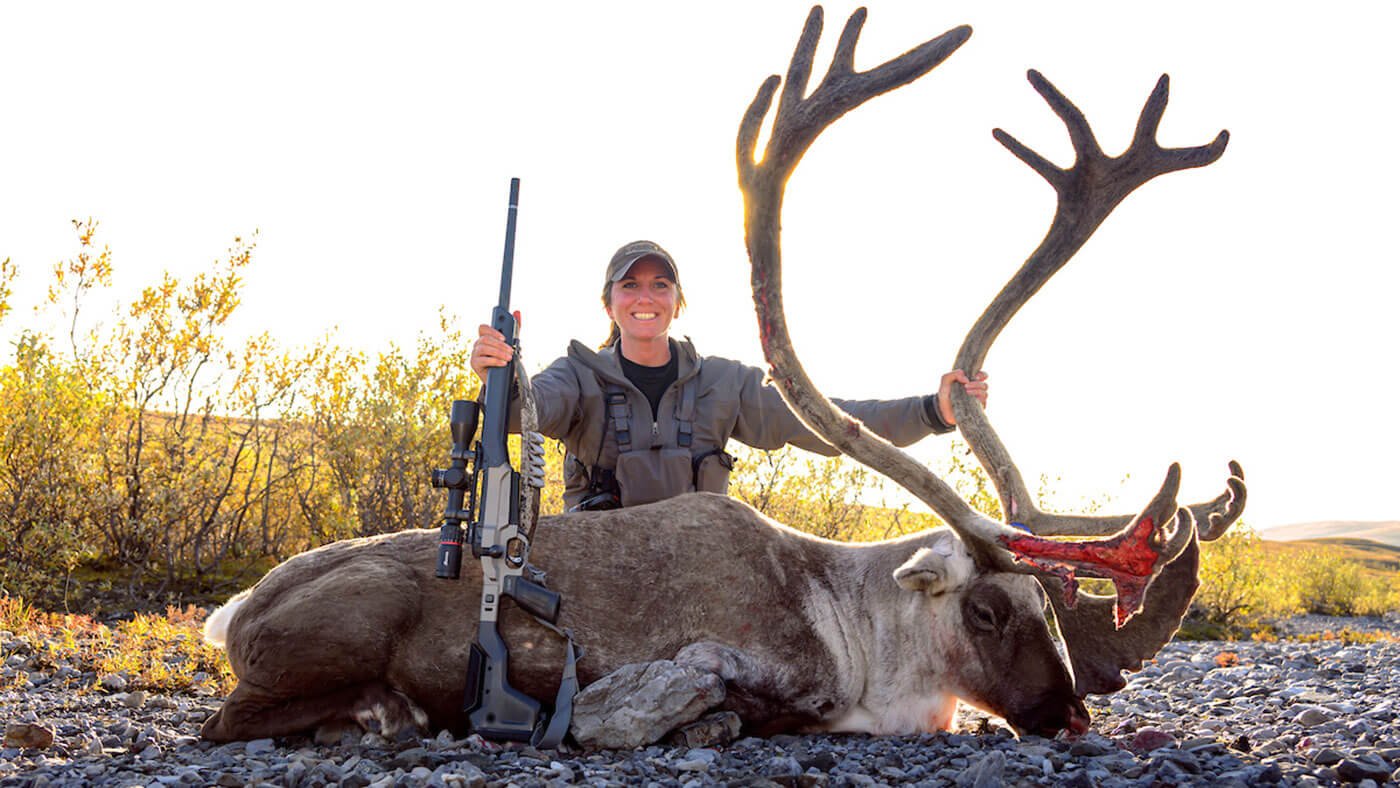
It was now 7:00pm. We made the call that we needed to be walking back to camp by 9:00pm. That would give us full light the three miles back to camp. As a team, we divided and conquered the tasks at hand. Tess and Kali got to work on the bull, I pulled Bear duty, and Kelsey did a little of both. For two hours, I stood and watched the surrounding area, sidearm in my hand always. We were on the river flat, in the willows, exactly where George or his friends may be cruising at the end of the day. For 90 minutes, there was little excitement except for some young bulls, cows, and calves crossing near us to head up the ridge for the night. But at 8:30pm, I was watching the same draw that Kali nearly shot across for her bull, and I saw a blonde figure moving along the hillside. In my calmest voice, I alerted the group that I saw a bear, although it was 600 yards away and moving away from us. We determined that it was in fact George, and he had been in the draw the entire afternoon we were sitting and watching the bulls in the flat and on the hillside across the draw. I can only imagine what would have happened if Kali had shot across the draw, and we would have been dressing out her bull in the bottom of the draw that night. I am a firm believer that things happen for a reason, and someone was watching out for us on that one. I spent the next half hour watching the bear work away from us and slowly cross over two ridges. We were safe, at least from George.
As we loaded up our packs for the three-mile hike out, we made quick work of packing up the meat and getting moving. We were all on edge, having seen a bear twice that day, and another one close to camp earlier in the trip. We took guesses at how long the journey would take us, but Kali called it, we all had a little more adrenaline pumping and we made it back to camp well before our 11:00pm target time. Backs hurting, legs burning, but we did it. Three bulls down in three days.
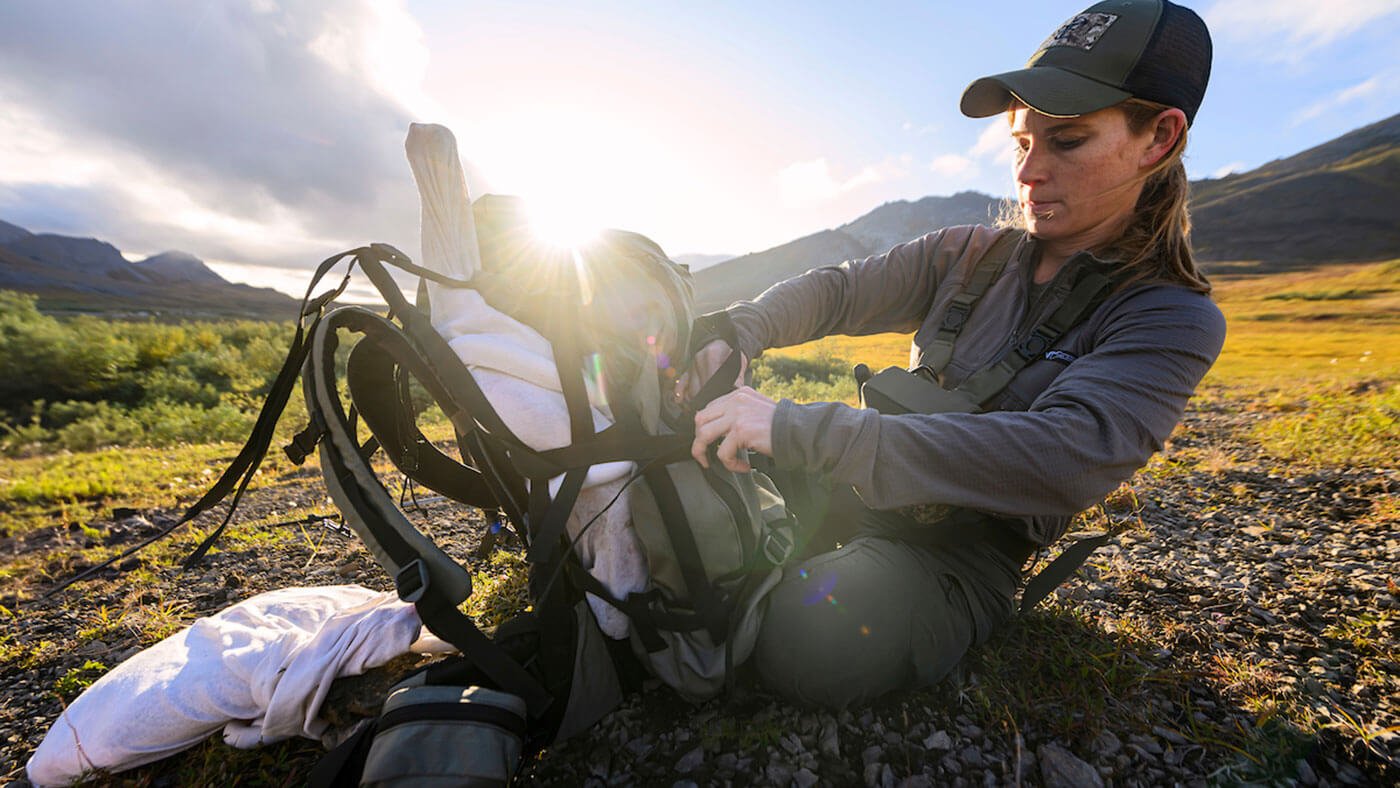
After a quick meal and getting cleaned up, it was nearly 1:00am before we headed for the sleeping tent. As a few of us were getting ready, we heard Tess say, “the northern lights are out!” This is what we had all hoped we would get the chance to see. As we all ventured out of the tent, the four of us lay on the ground, staring up at the amazing light show in the sky. What looked like clouds or fog began to dance and put off an amazing green hue. I don’t know about the others, but this is maybe my favorite memory from the trip. So far off the grid, staring at an amazing wonder in the sky, with my hunting partners. It made me feel so small yet filled me up at the same time. We all went to bed that night feeling a little more relaxed and blessed to be where we were and doing what we were doing. But we all know that things can change quickly.
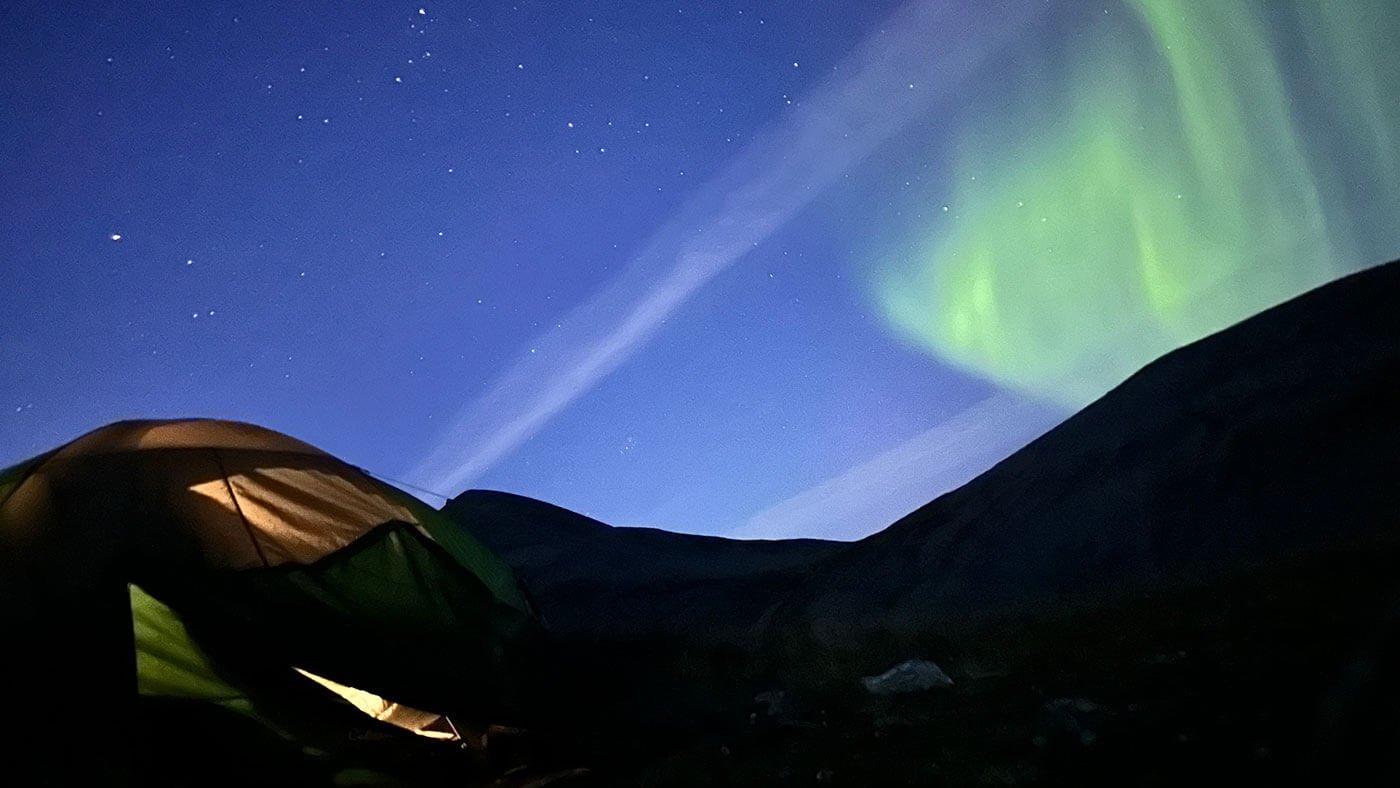
It was now Sunday morning, and we had been watching the weather on our Garmin’s for a few days. We knew that Monday and Tuesday looked like rain and wind, and the planes would likely not be able to fly in to get us. We were scheduled to be picked up on Tuesday if the weather allowed. This business is all about the weather. We were not done with our work in the field. Kelsey and I had to move our meat closer to camp, remove the antlers, and Kelsey had to cape out her skull. We knew this would take some time. We also had Kali’s antlers, hide, and rib meat still in the field, three miles away from camp. And Tess had yet to get the bull that she came for. As we started communicating with the pilots, it became clear that two of us would leave camp today, or all of us would likely be stuck in the field, for at least one extra night if not more. We made the tough decision to split up. Tess and Kali went off into the valley, and Kelsey and I got to work, moving our meat the 550 yards to the runway, and then getting our gear packed up for a 3:30pm pick up.
I had very mixed emotions about this decision. I had prepared to spend seven days and six nights in the field. We had made it five days and four nights. I felt like I wasn’t completing what we had signed up to do. I also know, that if any two women were able to take care of themselves out here, pack out Kali’s bull, and get another on the ground and back to camp, it was the two women we were leaving behind. So, with a sad feeling in my gut, yet some sort of relief, Kelsey and I loaded up our gear, boarded the Cessna, and flew out of the valley where we had made our home for the last few days.
Late that night, as Kelsey and I cleaned our meat and packed everything for the flight home, we got the message from our inReach that Tess had a bull down! As happy as that made us, we also felt some guilt. Kelsey and I would not be there to help lighten the load to get her meat out, and we knew the work they had ahead of them. We learned that they were able to get one load out that night before the weather took a turn for the worse.
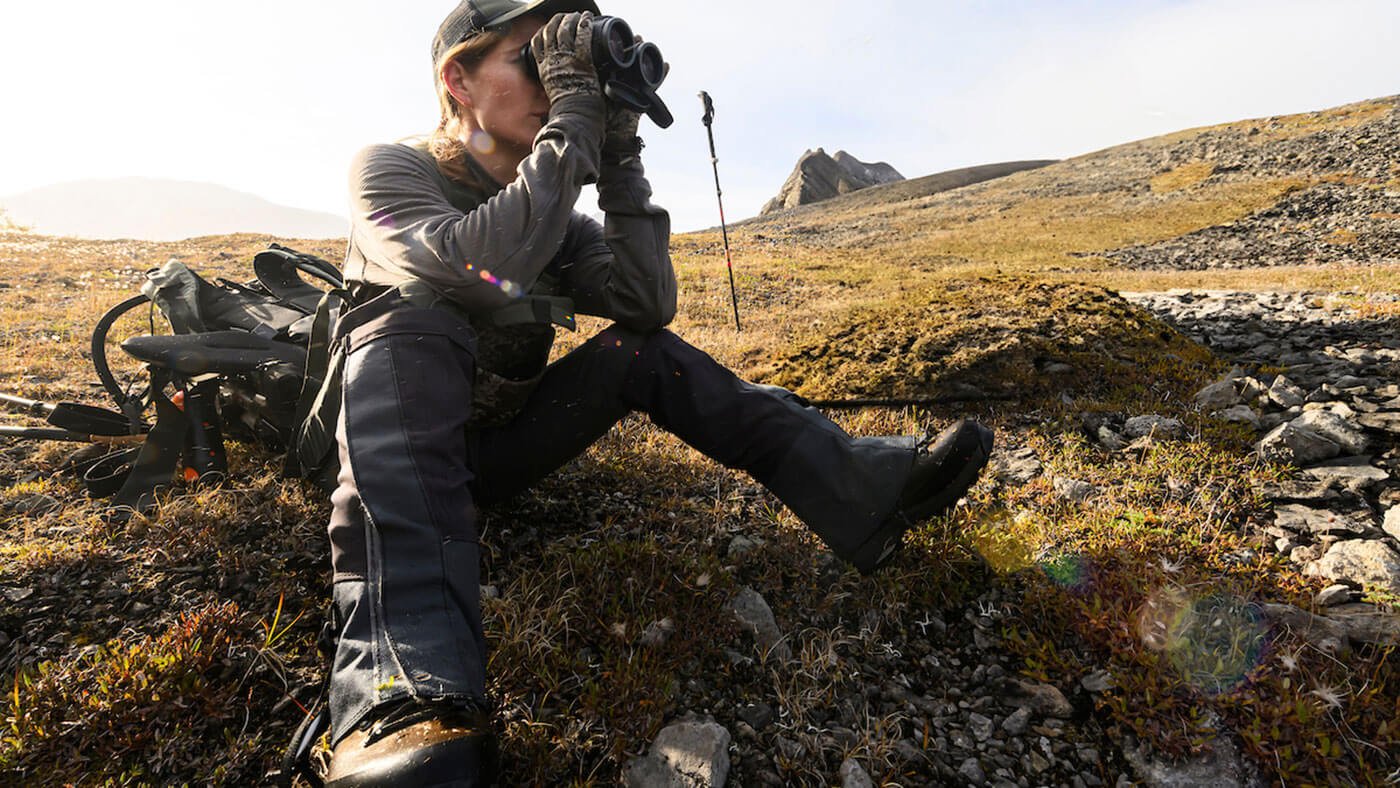
The next morning, the rain and wind arrived. We got word that George, or a relative, had gotten Kali’s rib meat, but her hide and antlers were in good shape. A bear had also been on Tess’s carcass, but everything else was undisturbed. I don’t know how heavy their packs were, or how many trips they made, but Tess and Kali put in 16 hard miles that day getting everything safely back to camp. After all that work packing out in the rain, they should have been able to sit back, dry off, and relax, but the weather did not allow that. Wind had broken one of the tent poles and damaged the rain flies. Water was now in the tents, and everything was wet. Kelsey and I felt helpless as we got the reports from camp over the next two days. More rain hit them every day. The wind was so violent throughout the camp that they hardly slept due to the tents being thrashed around. And to add to the misery, they were not able to be flown out on the original date planned, they would spend at least one extra day in the field.
Finally, as Kelsey and I sat at home after our day and a half of travel back from Alaska, we got word that Tess and Kali would be flown out late Wednesday, only one day longer than they had planned to be in the field. The teardown of the entire camp fell to them, as Kelsey and I only took our gear and what we used in camp. With a hotel room waiting for them and flights pushed a day, the final two made their way out of the tundra, after grinding it out to finish the hunt going four for four on bulls.
Back home, I have not stopped thinking about the trip or the hunt. My freezer has a tremendous amount of caribou meat that I get to process. But my mind is playing back to the key moments that stick out in my mind. And of course, as any hunter does, I am second-guessing the speed at which I chose to take my shot and finish my hunt. Hindsight is 20/20. More than anything, I am taking what I learned, and all my experiences, and making mental notes for future hunts. This was the toughest hunt I have done in my young hunting career. It would not have been possible without the other three amazing women I had with me. And like most hunts or great adventures in life, this one keeps me wanting more. Until the next adventure, Alaska.
